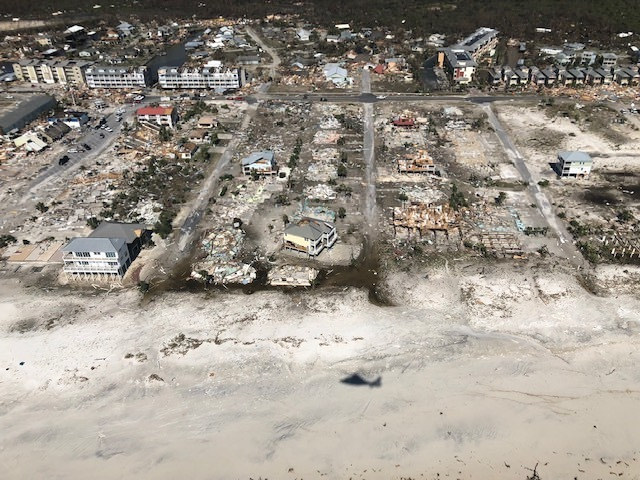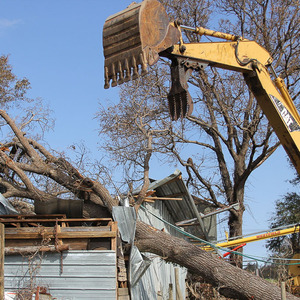
On Oct. 12, The New York Times published a series of photos taken along one mile of highway extending north from Mexico Beach, Florida, where just two days earlier Hurricane Michael swept ashore with 155 mph winds.
The Category 4 storm was the strongest ever to hit Florida’s Panhandle, and the aerial photos showed a devastated landscape of ruined or missing homes and businesses, and the tangled wreckage of boats and piers.
But the devastation was not complete. Although many buildings were gone, here and there stood a survivor. One of them is a house built just last year to standards far exceeding local building codes. The house, used as a rental when its two owners are not in town, suffered only minor damage while buildings all around it were swept away.
In an article about the building, named the Sand Palace by owners Russell King and his nephew LeBron Lackey, the house was described as the last beachfront home left on the block. Lackey, who lives in Cleveland, Tennessee, told the paper, “We wanted to build it for the big one. We just never knew we’d find the big one so fast.”
The article lists a few of the construction details, but also leaves big blanks. Neither Lackey nor the architect, Charles A. Gaskin, could be reached to provide any more information.
What we do know is the house is made of steel-reinforced concrete and constructed on pilings sunk 40 feet into the sand. Eaves were kept to a minimum so the wind would have less of a grip on the roof, and the pilings kept the house above the storm surge. While counties in that part of the Panhandle require buildings be able to resist winds of 120 to 150 miles per hour, Lackey and King built theirs to handle 250 mph winds.
The Times said the only real damage was the loss of a stairway providing access to the house and the bit of siding that surrounded it. The house was designed so that winds could tear that part of the structure away without destroying anything else. Elsewhere, one window in the shower was cracked, and the owner reported minor water damage.
News reports focused on the immediate coast. But as The Washington Post reported, people living far inland also faced challenges. In Marianna, 50 miles from the coast, buildings in the downtown area were badly damaged after the community took a direct hit.
Many people in the Panhandle live on dirt roads that are now blocked by fallen trees. Many residents decided not to evacuate because they were so far from the coast.
“Nobody thought it was going to be this devastating,” retired firefighter Sean Collins told the newspaper.
What residents can expect now
Recovery is likely to be slow, Kim Slowey reports at Construction Dive. There is no electricity in the areas hit hardest by the storm, and even the utility crews working around the clock may not be able to restore power for some time.
Florida building codes were toughened after Hurricane Andrew did some $25 billion in damage in 1992. Florida also has some of the most stringent licensing requirements for builders in the country, but past experience suggests that state officials may be willing to relax some regulations in order to speed up repairs.
Last year, after Hurricane Irma struck, Gov. Rick Scott ordered that state-licensed contractors be allowed to repair and replace roofs, rather than subcontract roofing work as required by state law. In 2004, the governor at that time, Jeb Bush, did the same thing after four hurricanes came ashore in a single year. That order also permitted out-of-state roofing contractors a limited amount of time to work in Florida.
Two problems that local residents are likely to encounter, Slowey said, are an increase in scam artists looking for a quick buck, and a shortage of both building materials and labor.
Companies that specialize in storm recovery are already very busy in the Carolinas and Virginia as they continue cleaning up after Hurricane Florence. Even last year’s Hurricane Harvey is still keeping contractors busy in Texas.
Not even a week has passed since Hurricane Michael struck Mexico Beach, and it’s likely to be some time before officials there can figure out why a few buildings were left standing when so many others were not.
The Insurance Institute for Business & Home Safety (IBHS), a research organization supported by the insurance industry, has posted some resources for people hoping to rebuild and touts the benefits of its Fortified Home program.
Weekly Newsletter
Get building science and energy efficiency advice, plus special offers, in your inbox.















11 Comments
Would be interesting to see some analysis of the cost/benefit of such a building (as compared to the neighbors, who are likely to eventually have new homes paid for by insurance).
What a scary situation. If this were my second home I would clear the lot and wait as long as possible before I rebuilt out of fear of workers taking shortcuts and overpaying.
Jon R,
They actually have done studies that show the cost/benefits of building a concrete structure to withstand storms far outweighs having a home destroyed and having to rebuild every decade or so. The environmental costs of having homes completely destroyed, then having to haul in lumber and goods and rebuild and replace everything, has a HUGE environmental impact.
The only people who LOVE this destroy and rebuild cycle are builders who make a lot of $$ framing up stick built homes, only to watch them fall down again.
I don't think the type of construction matters all that much - concrete, steel, masonry, timber-frame, stick-frame - they would all work if detailed appropriately.
This is very interesting, i am curious about the rest of its construction details and how one can build for similar levels of resiliency.
I spent nearly 20 years on the island of Guam (a US territory), where typhoon (and earthquake)-proof, steel-reinforced concrete houses are code-required. Walls typically are constructed on slabs using cinder blocks that are filled with grout and rebar as the walls go up. Wall rebar ties-in with roof rebar; roofs are poured, steel-reinforced concrete and typically flat. These homes are simple to build and they survive BIG storms; but they aren't cheap. Building cost goes up where, as in the case of the "Sand Palace," reinforced-concrete pilings and posts are needed to overcome an unstable substrate and raise the building above a potential flood. The biggest problem I witnessed in Guam homes/buildings is that corroding rebar typically/eventually destroys these structures from within by spalling that, once it begins, isn't easy (nor cheap) to stabilize/repair. It's a serious problem in tropical marine environments where salt spray and humidity are pretty much always present. Of course there are ways to minimize this problem during construction (and good maintenance helps, too), but as with so many important building details, the devil often gets there first.
Malcolm,
Details? I have never seen, read or heard of a stick frame home being able to resist 250mph winds and wind driven rain.
Poured in place reinforced concrete or tilt-up concrete is the time tested and proven method of construction for such high-risk wind areas.
I try to avoid company self-promotion here but this is one instance where it seems appropriate to mention what my company, Deltec Homes, does: manufacture hurricane-resistant, panelized, wood-framed home kits, including one of our own that stood up in Mexico Beach. We have drone footage of that home here: https://www.youtube.com/watch?v=TtJFc17bWM0 The home was under construction during the hurricane, not completed, and it looks like some of the shingles did blow off, but, structurally remained in tact. Our website has more stories of our homes taking hits from hurricanes, we've been doing this for multiple decades. https://www.deltechomes.com/learn-more/hurricane-resistance/
I'm our building scientist, not one of our structural engineers, but I hang out with our structural engineers sometimes, and my observation is that high wind resistance with wood framed construction is made possible through a whole suite of connection details, design details, and high quality material choices combined. Our signature method is an alternate shape: a polyangular shape with radial trusses to redistribute load, and a multi-faceted hip roof. But it's also in using plywood sheathing and very high quality truss lumber, highly engineered connections, and also just targeting the high wind market so that every detail, and every process, looks at high wind implications. Even things like roof pitch choice has a role to play. I would think that panelized construction (that is, off-site fabrication of panels, no matter what the panels are made of) in general would lend itself to high-wind resistance based on the ability to build each house section to very controlled specifications.
Also, programs like Fortified Homes offer good guidelines for the kinds of details that make a difference, no matter the construction type.
Very interesting, i have many questions
Can your processes work with many designs/layouts or do you have a few that are "proofed" and they are the designs you offer?
How tolerant is your method(s) to different materials, if someone wanted to use insulated Zip sheathing for example would that work with your design?
How much are your designs dependent on extra fasteners compared to building as usual, are there extra thermal bridges or more metal used to get the resilience and how much would this impact insulation effectiveness?
Alan B,
I'm sorry it took me so long to respond...I gotta set up email alerts up for comments.
Our particular process allows for a fully customize-able floorplan within the confines of some set building blocks--there are 10 different sizes of base poly-angular structures, you can stack those in multiple stories, or add wings and connects of various widths and lengths, etc.
We do not have the ability to use alternate materials from our spec for the key structural components: lumber, plywood, fasteners, as we have selected specific materials for their quality and wind speed performance. For example, we have looked at the ZipR and determined it doesn't easily meet our shear strength requirements with our specific design, but we can do insulated sheathing in wind zones by adding rigid foam outboard of the base plywood sheathing and face-nailing the siding. For materials that aren't part of the core structural package, like windows or siding, we have specific products we use but also allow clients to supply their own if they have a preference.
I am not our structural engineer to quantify exactly how heavily each weighs, but I would posit that our high wind success leans on the wind efficiency of the shape, on our use of very high quality lumber and sheathing materials, and on increased fasteners or otherwise beefed up fastening details (some of it is about locating plywood seams appropriately, not just more or bigger fasteners), each relatively equally. Our design does have extra wood framing when compared to typical wood construction, and uses one steel component in the center of the self-supporting roof. Some of the higher wood framing factor is in the panelized nature of the design as each wall panel must have studs on both ends to attach corners together; and much is in the radial shape, that dictates our corner design and has tight framing factors in the middle but more spaced out factors on the outside. That radial shape is in turn a part of what makes the design withstand winds, etc.
In high wind zones, I do think one must generally accept some trade-offs between strength and thermal concerns in favor of the strength concerns, whether that's looking at using steel or concrete, or wood with a higher framing factor, or some fastening details that aren't thermally ideal, etc. Thankfully the highest thermal load locations are not the same places as the highest wind load locations; the cost-benefit equation on any given thermal bridge on the Florida coast, for example, or even the New Jersey coast, is not the same as it is for an inland area with very high HDD. Meanwhile other strategies like improved air-tightness (which we can do really well with a panelized system) or exterior insulated sheathing (when fastening details of your siding allow you to do it) tend to be pretty helpful alternate ways to beef up efficiency in the milder temp climates of coastal high wind regions.
Thanks for your reply and no worries on taking a while to respond, the same happened to me ;)
These are very interesting answers, if i were building a house resilience would be one of my goals in design as well as insulation, though i assume you can model your plans in BeOpt or Hot2000 or PHPP or something equivalent to see what the tradeoff actually is. For most who are not going Passivhaus a slight penalty is probably not a big deal.
Log in or create an account to post a comment.
Sign up Log in